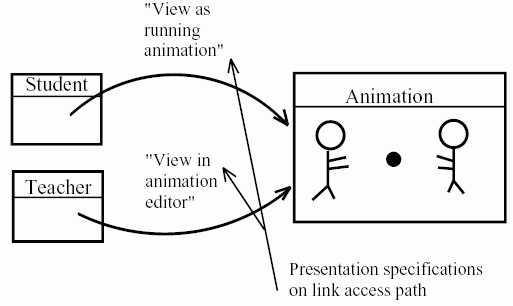
Presentation SpecificationsThe mechanism of the anchor identifiers can be combined with the component specification mechanism to provide a way of specifying the endpoints of a link. In the Dexter model, this is captured by an entity called a specifier which consists of a component specification, an anchor id, and two additional fields: a direction and a presentation specification. A specifier specifies a component and an anchor "point" within a component that can serve as the endpoint of a link. The presentation specification is a primitive value that forms part of the interface between the storage layer and the runtime layer. It contains information specifying how to present the anchor(s) in the displayed component. Figure below illustrates the importance of the presentation specifications mechanism:
Source: Halasz, F., Schwartz, M., The Dexter Hypertext Reference Model, NIST Hypertext Standardization Workshop, February 1990. In this figure, there is an animation component taken from a computer-based training hypertext. This animation component can be accessed from two other components, a “teacher” component and a “student” component. When following the link from the student component, the animation should be brought up as a running animation. In contrast, when coming from the teacher component, the animation should be brought up in editing mode ready to be altered. In order to separate these two cases, the runtime layer needs to access presentation information encoded into the links in the network. Presentation specifications are a generic way of doing just this. Like anchoring, it is an interface that allows the storage layer to communicate in generic way with the runtime layer without violating the separation between the two layers. |
| CS6212 - Special Topics in Media Lecturer: Prof George P. Landow |
Final Term Project By: Hendrik Christanto |
